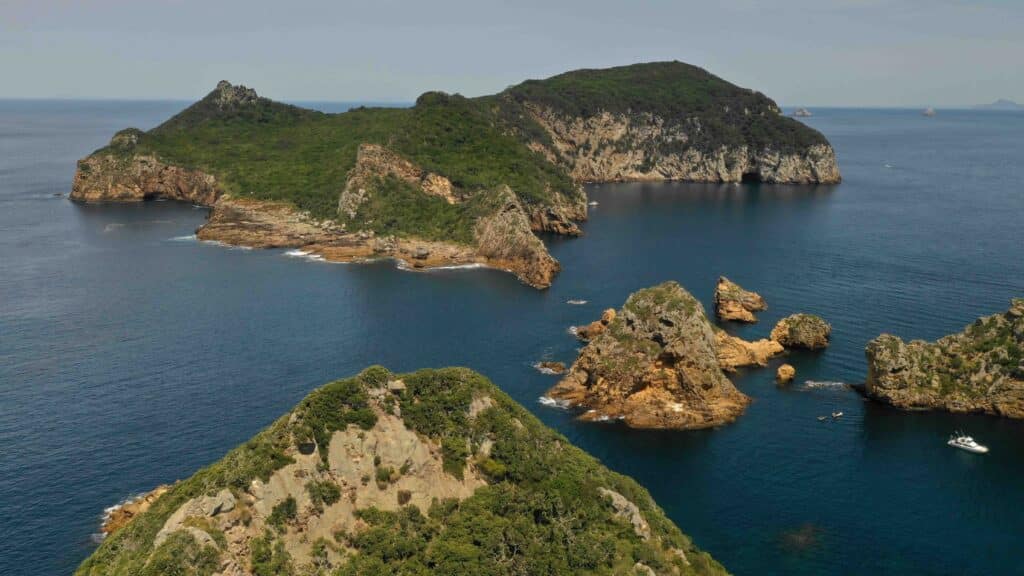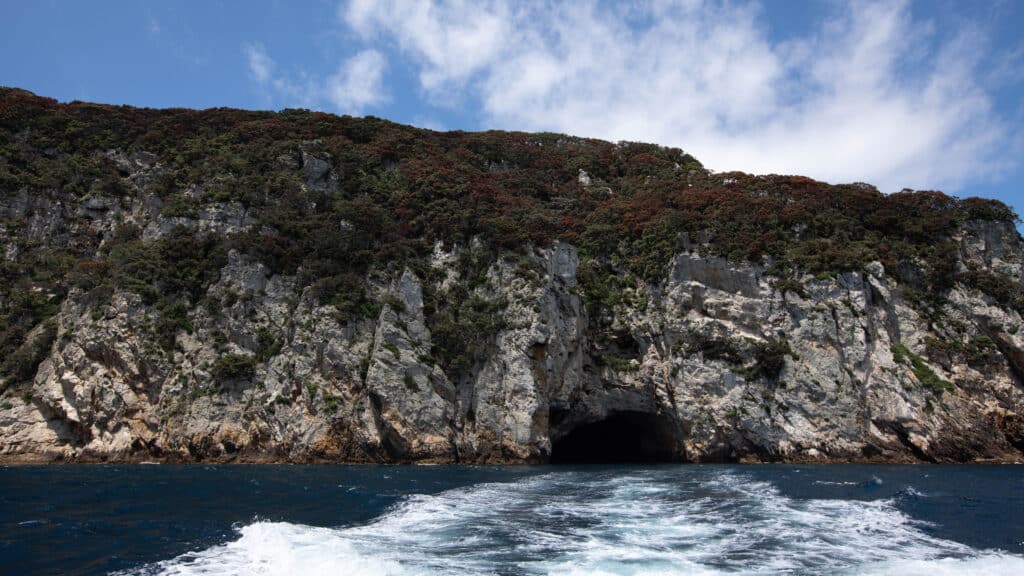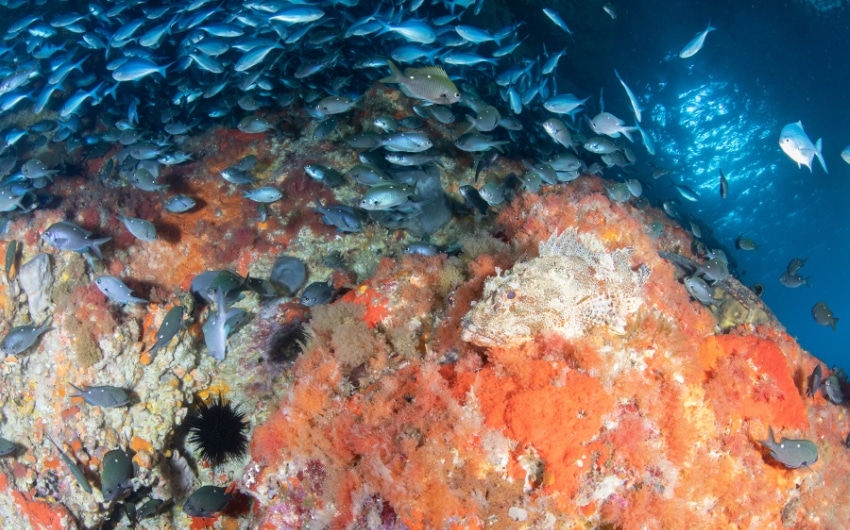
The Water Cycle at the Poor Knights Islands
Since the Poor Knights Islands are surrounded by the ocean and have no freshwater streams or rivers, the water cycle operates a little differently here. Let’s break it down:
1. Evaporation & Transpiration
- The sun heats the ocean, causing seawater to evaporate into water vapor.
- Plants on the islands (like pohutukawa trees) release moisture through transpiration, adding more water vapor to the air.
2. Condensation
- As the warm, moist air rises, it cools down over the islands.
- Water vapor condenses into tiny droplets, forming clouds and mist, which often hover around the islands.
3. Precipitation
- Eventually, the condensed water droplets become too heavy and fall as rain.
- This is a key water source for the islands since there are no rivers or lakes.
4. Infiltration & Runoff
- The rainwater soaks into the island’s volcanic rock and soil, providing moisture for plants and filling tiny underground pockets of water.
- Since the islands are steep, most excess water runs off into the ocean, carrying organic matter that helps support marine life.
5. Ocean Circulation & Upwelling
- Unlike on land, much of the water cycle at the Poor Knights involves ocean currents.
- The warm East Auckland Current brings nutrient-rich water from the tropics, fueling marine ecosystems.
- Upwelling—where deeper, cooler water rises to the surface—brings nutrients that support plankton, fish, and larger marine animals.
Why this matters for the Poor Knights Ecosystem?
- The islands depend entirely on rainfall for freshwater.
- The unique misty microclimate helps sustain rare plants and animals.
- Ocean currents and nutrient cycles drive the incredible marine biodiversity below the surface.
Ever noticed how mist often clings to the islands in the mornings? That’s part of this cycle in action!

Phytoplankton & the Water Cycle
Phytoplankton are microscopic, plant-like organisms that float in the ocean. They play a huge role in both the water cycle and the health of marine ecosystems—including around the Poor Knights Islands.
How Phytoplankton Connect to the Water Cycle
- Evaporation & Cloud Formation
- Phytoplankton release gaseous compounds like dimethylsulfide (DMS), which help form clouds by encouraging water vapor to condense.
- This influences rainfall patterns over the ocean and coastal areas like the Poor Knights.
- Precipitation & Nutrient Flow
- Rain brings nutrients from the atmosphere and land into the ocean.
- This helps phytoplankton grow, especially near upwelling zones where nutrient-rich deep water rises to the surface.
- Ocean Currents & Circulation
- The East Auckland Current brings warm, nutrient-rich water from tropical regions, feeding phytoplankton blooms around the Poor Knights.
- Upwelling events near the islands stir up deep-sea nutrients, fueling phytoplankton growth and supporting the marine food chain.
- Oxygen Production & Carbon Absorption
- Phytoplankton produce over 50% of Earth’s oxygen—more than all rainforests combined!
- They absorb CO₂ from the atmosphere, helping regulate climate and the ocean’s carbon cycle.
Phytoplankton at the Poor Knights Islands
The rich waters around the Poor Knights support seasonal phytoplankton blooms, which:
Feed zooplankton, small fish, and filter feeders (like sponges and corals).
Contribute to the incredible biodiversity of the marine reserve.
Influence visibility—blooms can make the water greener, while clear water often means fewer phytoplankton.
Have you ever noticed changes in water colour or visibility on your trips? Those could be signs of phytoplankton activity!

Phytoplankton in the Atmosphere
Phytoplankton are tiny ocean plants, but they have a big impact on the atmosphere. They don’t just stay in the ocean—they release gases and particles that affect cloud formation, climate, and even rainfall patterns.
How Phytoplankton Influence the Atmosphere
1. Cloud Formation
- Phytoplankton produce a compound called dimethylsulfoniopropionate (DMSP), which breaks down into dimethyl sulfide (DMS).
- DMS rises into the atmosphere and reacts with oxygen to form sulfate aerosols.
- These aerosols help water vapor condense into clouds, increasing cloud cover and reflecting sunlight—cooling the planet.
2. Carbon Absorption & Climate Regulation
- Through photosynthesis, phytoplankton absorb massive amounts of CO₂ from the atmosphere.
- When phytoplankton die, some sink to the ocean floor, locking away carbon for centuries in a process called the biological carbon pump.
- This reduces greenhouse gases and helps regulate Earth’s climate.
3. Ocean-Atmosphere Interaction
- Warm ocean water encourages phytoplankton growth, which increases DMS emissions.
- More DMS = more clouds = more sunlight reflected, creating a natural climate feedback loop.
- However, if ocean temperatures rise too much, some phytoplankton die off, which could disrupt this balance.

The “sea smell” that you often associate with the ocean, especially around areas with abundant phytoplankton, is largely due to the presence of dimethyl sulfide (DMS), a compound released by these tiny ocean plants.
How Phytoplankton Contribute to the Sea Smell
- DMS Release
- Phytoplankton produce dimethylsulfoniopropionate (DMSP) as part of their normal metabolic processes.
- When they are broken down (either naturally or by bacteria), DMSP is converted into dimethyl sulfide (DMS).
- DMS is a volatile compound, meaning it easily evaporates into the air, giving off a distinctive sulfur-like smell often associated with the sea.
- Role in the Ocean’s Ecosystem
- DMS helps phytoplankton survive by acting as a natural antifreeze, protecting them from stress in colder water.
- As DMS enters the atmosphere, it plays a role in cloud formation and can contribute to the cooling of the planet by reflecting sunlight.
- Where It’s Strongest
- Areas with high concentrations of phytoplankton blooms (like around the Poor Knights Islands) or in upwelling zones often have the strongest sea smell.
- You’ll notice the scent is especially noticeable when there’s a lot of biological activity happening in the water.
Why the Smell Can Be More Noticeable
- Warm weather and calm seas can make the DMS more concentrated in the air.
- When phytoplankton are abundant, their breakdown and release of DMS increases, making the sea smell stronger—sometimes even with a hint of that “rotten egg” scent due to sulfur.
So, next time you’re out on the water, that sea scent you’re breathing in is partly due to phytoplankton doing their important work in the ocean. Quite the natural perfume, isn’t it?
